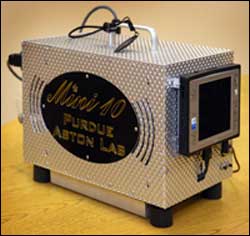A heatable array for the amplification and chemical analysis of nucleic acids.
…
Multimedia providers and distributors are being sought by Leeds researchers, to test some of the latest technology for handling digital media such as music, games and TV.
In today’s digital world, multimedia entertainment reaches us in a huge variety of ways, whether it’s films watched on a laptop, interactive games on our mobile phones or music downloaded through the internet. As technology advances, these outlets proliferate, raising problems of compatibility and copyright prote

Researchers at Purdue University have shown how a new ultra-fast chemical-analysis tool has numerous promising uses for detecting everything from cancer in the liver to explosives residues on luggage and “biomarkers” in urine that provide an early warning for diseases.
The analytical chemists have most recently demonstrated how the technology, called desorption electrospray ionization, or DESI, rapidly detects the boundaries of cancerous tumors, information that could help ens
New class of selective inhibitors paralyze essential plasmodium enzymes
The most dangerous variant of the malaria parasite, Plasmodium falciparum, infects up to 600 million people every year. The search for new effective therapies is thus an urgent area of research. An international team headed by François Diederich has now found a new point of attack: using a novel class of inhibitors, the researchers aim to block certain plasmodium enzymes known as plasmepsins, “starving ou
Botulinum neurotoxin A can be either the greatest wrinkle remover or one of the world’s most potent biological weapons. To perform either job, however, the toxin must first find a way to enter cells.
But understanding how the toxin — one of seven neurotoxins produced by the bacterium Clostridium botulinum — enters nerve cells has proved elusive for scientists. Despite a decade-long search for the receptor by labs around the world, researchers had come up empty handed.
– Combinatorial biotransformation of biologically active compounds belonging to different chemical substance classes
…